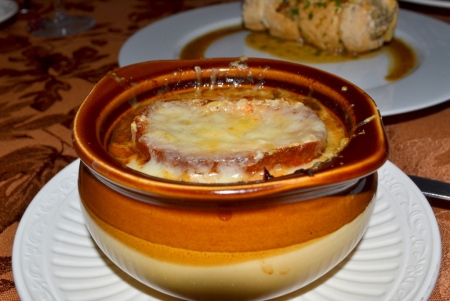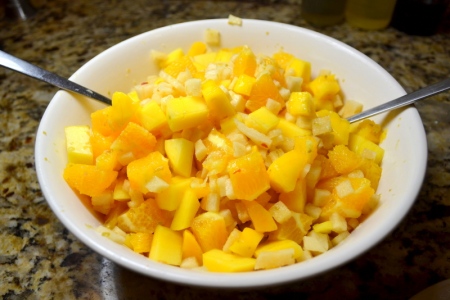Every time I see a particular friend of mine she always reminds me how much she loves this onion soup. So I made this recipe for her again, following all my tips/suggestions from the last time I made it. I even splurged on a full pound of Gruyere cheese. While the soup was delicious and universally praised by my guests as “better than the last time”, I was unhappy with this attempt because of my pet peeve; soggy bread. Ideally, I want the bread to absorb just enough of the soup to soften and become flavorful, but not to absorb so much liquid that it becomes a mushy and begins to disintegrate. Today I offer more specific suggestions to reliably avoid this common pitfall. Hopefully.

Came out good, except for the soggy bread.
The 7 Rules to the Best Onion Soup are:
- First and foremost, A weakness in Chris Kimball’s recipe is that the most important flavor-building step happens near the end of cooking. The first time I made this soup, the onions over-cooked in the oven and I had to skip the triple de-glazing the pan in Steps 7 and 8. I recommend erring on the side of caution. Lower the oven temperature from 400-degrees to 375-degrees (with convection turned off). That will mean a little more time on the stovetop, so maybe you can even quadruple de-glaze. Rule #1. Cooking the onions for 4+ hours will build lots of flavor, but be careful they don’t burn.
- It’s easy to ruin your flavorful soup with soggy bread. You need to limit the time that the bread makes direct contact with the soup. This requires planning, making sure that your table is set, that you have saucers at the ready, and that your guests are ready for dinner. This was my first problem; everybody was still in party mode and took 10 minutes to get to the dinner table. An extra 5-minutes saved will make an enormous difference. Rule #2. Never put the toast on the soup until the table is set and the guests have been told it’s dinner time.
- Once your guests take their first bite of soup the onus is on them to manage their own bread. Your responsibility is to insulate the bread from the soup to slow down the rate of absorption before your guests being to eat. The only way to do that is with an even layer of finely grated cheese between the soup and the toast. So to be clear, you need two layers of cheese. The “primer” layer of cheese will keep your bread floating above the soup’s surface, safe from the liquid ravages of the cauldron below. Melt and brown your first layer of cheese too (because it will taste better) and to ensure your cheese has complete coverage. Sprinkle a little raw cheese to cover any bare spots. In my haste, I used a food processor to grate the cheese, which was too coarse and let too much liquid through. My downfall was certain when the toast partially submerged. Rule #3. Top your soup with an even layer of finely grated cheese before adding the toast.
- Make sure the baguette you buy is light and airy. You need an open crumb so that the crouton won’t become sponge-like. You want a thick, crispy crust that will stand up better to the soup. Don’t worry so much about the diameter of the bread. By changing the bias on which you cut your 3/8″-thick slices, you can adjust the diameter of the bead to fit your bowls. I bought the baguette from a new bakery and the crumb was much to fine (similar to sandwich bread). Rule #4. Buy a baguette with a light and airy crumb.
- Many people advise to use day-old bread, but you should toast your fresh bread slices in an oven until deeply golden brown. Chris Kimball did some tests and found that stale bread become hard, but does not properly dry out. Toast both sides until they become evenly and deeply golden brown. Chris Kimball’s recommendation of 10 minutes is insufficient; it’ll take at least 15 minutes. Rule #5. Don’t let your bread slices become so dark at to adversely affect their flavor, but toast them as long as you possibly can.
- Begin toasting your bread slices at least 40 minutes before dinner time. This will give you enough time to make a second batch, should that contingency become necessary. I’m the first to admit, I routinely forget that I have croutons in the oven and ruin at least half my batches. Aim for success the first time, but also recognize that you will be extremely busy as your dinner is coming together. You may forget and you probably used less than half your baguette anyway. Rule #6. Your toast will be successful only 50% of the time; plan accordingly.
- A shameful confession: For some recipes I use bouillon cubes instead of real broth. It’s cheaper and easier to keep a box of small cubes than a case of liquid broth. But this is not the occasion to use bad broth. Rule #7. Don’t skimp on the broth; a high-quality broth makes a big difference.
I’m am going to give another attempt at following my Rules #2 through #6 very closely. If I still cannot reliably avoid soggy bread, then I am going to try the tip for those without broiler-safe crocs: simply broil the cheese and bread slices on a baking sheet, then slip onto the soup just before serving. Julia Child recommends adding 2 to 3 tablespoons of Cognac, something I still want to try but haven’t had any cognac. While the recipe says it will make 8 bowls, I was able to stretched this recipe to the maximum and got 9 bowls. I wanted to make 10 servings, but it just wouldn’t stretch any farther. And finally a few comments about the cheese. My local supermarket sells Gruyere for $24/lb, but there is a gormet supermarket 10 miles away that sells superior French Gruyere Comte. Officially the proper cheese is Swiss Gruyere, but I really like the French Comte. If you can’t afford imported Gruyere made with raw cows milk, then substitute 70% Jarlsberg with 30% fresh Parmesan. Don’t resort to domestic Gruyere made with pasteurized milk; it’s flavorless.
Rating: 4-stars.
Cost: $16 for eight servings.
How much work? Medium.
How big of a mess? Medium.
Started: 1:00 pm Ready: 6:00 pm.
Chris Kimball’s original recipe is here. The descriptions of how I prepared the soup today are given below:
4 tablespoons unsalted butter
6-lbs yellow onions
2-1/2 teaspoon table salt
3 cups water (plus up t0 1 cup more for deglazing)
3/4 cup dry sherry
6 cups chicken broth
3 cups beef broth
9 sprigs fresh thyme, tied together using kitchen twine
2 bay leaf
Ground black pepper
Cheese Croutons:
1/2 small baguette , cut into 3/8″ slices on the bias to match the diameter of your soup bowls.
12 ounces finely grated Gruyère cheese
- Cut your onions in half from pole to pole, and slice off the root end of onion. Peel and discard the the skin. Placing each onion half with the flat side down on cutting board, slice each onion half from pole to pole into 1/8″-thick slices.
- Set an oven rack to the lower middle position in your oven. Preheat to 375-degrees (with convection fan turned off).
- Spray the inside of a large Dutch oven with non-stick cooking spray. Place 4 tablespoons of butter, and onion slices into your dutch oven. Sprinkle with 1-1/2 teaspoon salt.
- Place the lid on to fully cover your dutch oven for the first hour of cooking. Then remove from oven and stir and scrape the bottom and sides. Return to oven, but with the lid slightly ajar, and cook for another 1-1/2 hours; stir and scrape the onions after 45 minutes. The onions should be very soft and lightly golden brown.
- Remove the onions from the oven and put on stove-top over medium to medium-high burner. Cook the onions for 15 to 20 minutes until all the liquid has evaporated and the onions have browned; stir and scrape the bottom and sides frequently. Adjust the heat if your onions are browning too quickly. It is easy to forget that the handles are 375-degrees; be very careful to use oven mitts.
- Meanwhile, slice baguette on the diagonal into 3/8″-thick slices. Match the diameter of your soup bowls by adjusting the angle on which you slice the bread. Place bread slices on foil-lined baking sheet, and bake for between 12 to 18 minutes in a 400-degree oven until the bread becomes crispy and golden brown. Also take advantage of any free moments to finely grate your cheese using the fine holes of a box grater (or ideally a microplane).
- Continue to cook onions without stirring for another 6 to 8 minutes until the pot’s bottom becomes coated with a dark crust. You may need to adjusting the burner to avoid burning the fond.
- To loosen the fond, stir in 1/4-cup water and scrape the bottom and sides. Continue to cook without stirring for another 6 to 8 minutes until the pot’s bottom becomes coated with a dark crust. Repeat this process of deglazing until the onions become very dark brown; 2 or 3 more times.
- Stir in 3/4-cup dry sherry to deglaze the pan. Cook for 5 minutes until the sherry has evaporated; stirring frequently.
- Now add both chicken and beef broth, 3-cups of water, thyme bundle, bay leaf, and 1 teaspoon table salt. Bring to a simmer over high heat, then cover and reduce to low heat and simmer for 30 minutes.
- Remove and discard herbs, then season with pepper (and adjust salt if necessary).
- Adjust an oven rack so that it is 6″ from the broiler element. Preheat broiler on high for 5 to 10 minutes.
- Fill each broiler-safe crocks with soup and place on your foil-lined baking sheet. Sprinkle soup with finely grated Gruyère so that it completely covers the soup. Broil for 3 to 5 minutes about 6″ from the broiler element until the cheese has melted and is bubbling around edges. If any spots show soup coming through, plus the holes with a little more raw cheese.
- Place 1 or 2 baguette slices with the crispy side down, being careful not to overlap your slices. Sprinkle with shredded Gruyère and broil for 3 to 5 minutes about 6″ from the broiler element until the cheese has melted and is bubbling around edges. Allow to cool for 5 minutes before serving.









 Posted by My Year With Chris Kimball
Posted by My Year With Chris Kimball 














